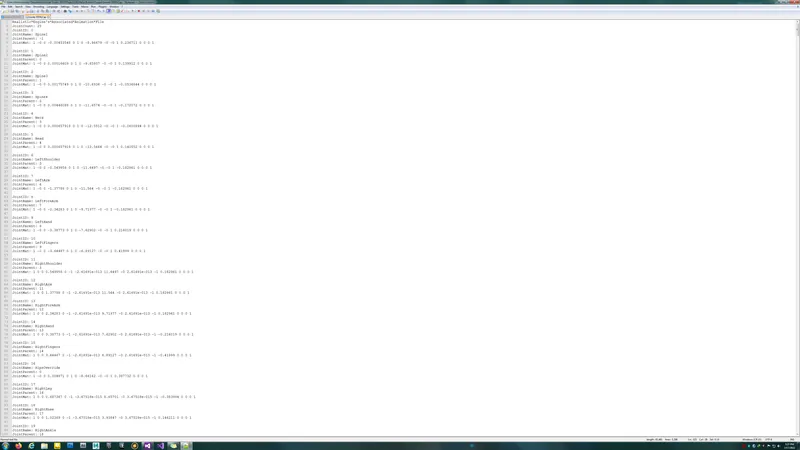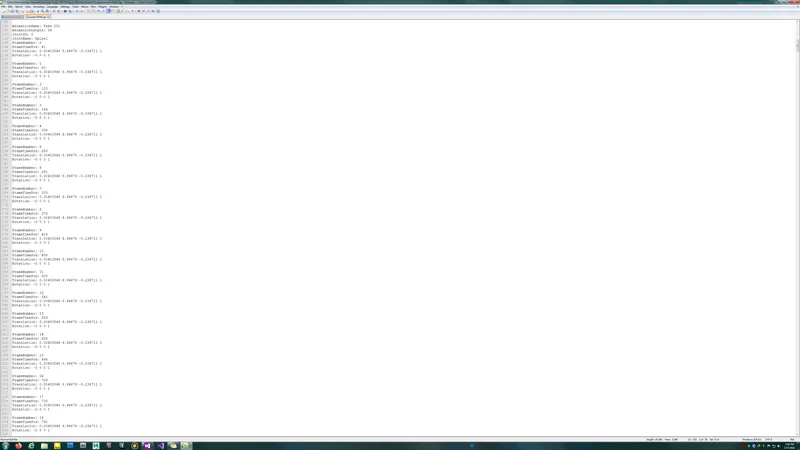Hi all,
I have a problem when it comes to the skeletal animations.
This works with FBX SDK.
void FBXUniLoader::BuildMatrices(FbxTime& fbxFrameTime)
{
for (unsigned long i = 0; i < mSkeleton.mJoints.size(); ++i)
GetNodeLocalTransform(mSkeleton.mJoints[i].mNode, fbxFrameTime, mSkeleton.mJoints[i].NodeLocalTransform);
for (auto& bone : mSkeleton.mJoints)
{
if (bone.mParentIndex != -1)
bone.CombinedTransform = bone.NodeLocalTransform * mSkeleton.mJoints[bone.mParentIndex].CombinedTransform;
else
bone.CombinedTransform = bone.NodeLocalTransform;
}
for (auto& bone : mSkeleton.mJoints)
bone.BoneMatrix = bone.Offset * bone.CombinedTransform;
}But when I exported those data to my own file format, it didn't work. I can't seem to understand why? Can anyone help me? problem lies with this code.
vector<XMMATRIX> RESrcLoader::BuildBoneMatrices(int inAnimID, float inTime)
{
vector <XMMATRIX> BoneMatrices;
inTime *= 1000.0f;
if (!mAnimations.empty())
{
auto ad = mAnimations[inAnimID];
for (auto &curjoint : ad.Skeleton)
{
if(inTime <= curjoint.Keyframes.front().TimePos)
{
XMVECTOR R = curjoint.Keyframes.front().Rotation;
XMVECTOR T = curjoint.Keyframes.front().Translation;
FbxVector4 vR, vT, vS;
vR.Set(R.m128_f32[0], R.m128_f32[1], R.m128_f32[2], R.m128_f32[3]);
vT.Set(T.m128_f32[0], T.m128_f32[1], T.m128_f32[2], T.m128_f32[3]);
vS.Set(1, 1, 1);
FbxAMatrix tmpMat;
tmpMat.SetT(vT);
tmpMat.SetR(vR);
tmpMat.SetS(vS);
FBXMatrixToXMMatrix(tmpMat, curjoint.LocalTransform);
}
else if(inTime >= curjoint.Keyframes.back().TimePos)
{
XMVECTOR R = curjoint.Keyframes.back().Rotation;
XMVECTOR T = curjoint.Keyframes.back().Translation;
FbxVector4 vR, vT, vS;
vR.Set(R.m128_f32[0], R.m128_f32[1], R.m128_f32[2], R.m128_f32[3]);
vT.Set(T.m128_f32[0], T.m128_f32[1], T.m128_f32[2], T.m128_f32[3]);
vS.Set(1, 1, 1);
FbxAMatrix tmpMat;
tmpMat.SetT(vT);
tmpMat.SetR(vR);
tmpMat.SetS(vS);
FBXMatrixToXMMatrix(tmpMat, curjoint.LocalTransform);
}
else
{
for (int i=0; i<ad.Length-1; i++)
{
if((inTime >= curjoint.Keyframes[i].TimePos) && (inTime <= curjoint.Keyframes[i+1].TimePos))
{
float lerpPercent = (inTime - curjoint.Keyframes[i].TimePos) / (curjoint.Keyframes[i+1].TimePos - curjoint.Keyframes[i].TimePos);
XMVECTOR r0 = curjoint.Keyframes[i].Rotation;
XMVECTOR r1 = curjoint.Keyframes[i+1].Rotation;
XMVECTOR t0 = curjoint.Keyframes[i].Translation;
XMVECTOR t1 = curjoint.Keyframes[i+1].Translation;
XMVECTOR R = XMVectorLerp(r0, r1, lerpPercent);
XMVECTOR T = XMVectorLerp(t0, t1, lerpPercent);
FbxVector4 vR, vT, vS;
vR.Set(R.m128_f32[0], R.m128_f32[1], R.m128_f32[2], R.m128_f32[3]);
vT.Set(T.m128_f32[0], T.m128_f32[1], T.m128_f32[2], T.m128_f32[3]);
vS.Set(1, 1, 1);
FbxAMatrix tmpMat;
tmpMat.SetT(vT);
tmpMat.SetR(vR);
tmpMat.SetS(vS);
FBXMatrixToXMMatrix(tmpMat, curjoint.LocalTransform);
break;
}
}
}
}
for (auto &curjoint : ad.Skeleton)
{
if (curjoint.ParentID != -1)
curjoint.CombinedTransform = curjoint.LocalTransform * ad.Skeleton[curjoint.ParentID].CombinedTransform;
else
curjoint.CombinedTransform = curjoint.LocalTransform;
}
for (auto curjoint : ad.Skeleton)
{
XMMATRIX BoneMatrix = curjoint.GlobalBindposeInverse * curjoint.CombinedTransform;
BoneMatrices.push_back(BoneMatrix);
}
}
return BoneMatrices;
}








